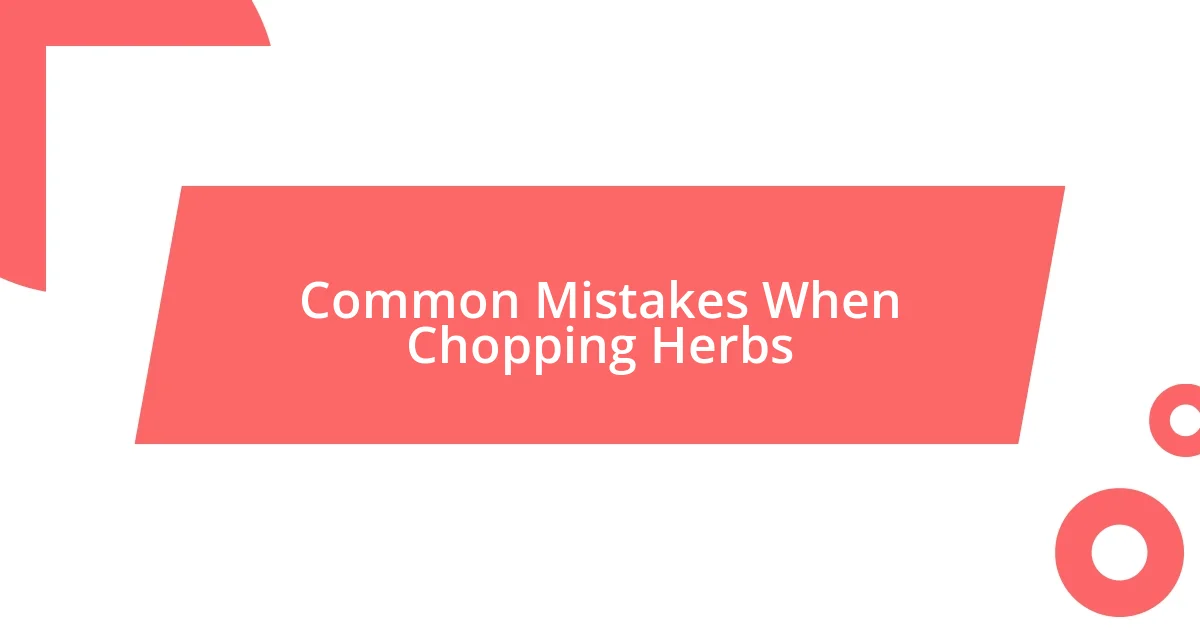Key takeaways:
- Herbs enhance flavor and nutrition in dishes, offering health benefits and a cultural connection.
- Essential tools for chopping herbs include a sharp chef’s knife, a wooden cutting board, and herb scissors for efficiency.
- Common mistakes when chopping herbs include not washing them, using dull knives, and chopping too finely; larger pieces can provide more flavor.

Understanding the Importance of Herbs
Herbs are more than just a garnish; they’re a burst of flavor and nutrition that can completely transform a dish. When I first started cooking, I remember the moment I finely chopped fresh basil for a simple pasta. The aroma enveloped my kitchen, and I was struck by how this tiny green leaf elevated the meal. Have you ever experienced that magic with fresh herbs?
Beyond flavor, herbs are packed with health benefits. For example, I’ve learned that parsley isn’t just a pretty plate decoration; it’s rich in vitamins and can aid digestion. It’s fascinating to realize how something so simple can contribute to our wellness—what other small changes can we make in our kitchens for a healthier lifestyle?
Furthermore, the cultural significance of herbs is captivating. I often think about the stories my grandmother shared about using rosemary to fend off evil spirits in her village. Now, every time I chop rosemary, I feel a connection to my roots and the traditions that have shaped my understanding of food. Isn’t it incredible how herbs can tie us to our past while enhancing our present experiences?

Essential Tools for Chopping Herbs
When it comes to chopping herbs, having the right tools can truly enhance the experience. I’ve found that a sharp chef’s knife is indispensable; it slices through herbs with precision, allowing for the delicate release of their oils. It’s interesting how a well-balanced knife can make such a difference—when I upgraded to a higher quality knife, the ease of chopping became a joy rather than a chore.
Another essential tool in my kitchen is the cutting board. I prefer a wooden board because it feels more inviting and absorbs the aroma of the herbs, creating a sensory experience. The slight friction of the wood against the herbs gives me better control, leading to a more even chop. I’ll never forget the first time I used a bamboo cutting board; the subtle earthy scent made me feel like I was immersed in nature while I worked.
A handy herb scissors is also a fantastic addition. At first, I was skeptical about using scissors for chopping, but now I consider them a game-changer for softer greens like cilantro. They allow me to cut multiple leaves at once, reducing the mess and time spent preparing. Have you tried using them? The experience of quickly snipping herbs into my dish reminded me of childhood days when my mom would let me help in the kitchen. It made cooking feel more collaborative and fun.
| Tool | Description |
|---|---|
| Chef’s Knife | A sharp, versatile knife that allows for precise cutting and enhances the release of flavor. |
| Cutting Board | A wooden board that provides a stable surface and absorbs flavors, making the cutting process enjoyable. |
| Herb Scissors | Specialized scissors designed for quick, even cutting of soft herbs without the mess. |

Techniques for Efficient Herb Chopping
When it comes to efficiently chopping herbs, there are a few techniques I’ve discovered that can significantly streamline the process. One of my favorites is the rocking motion with a sharp knife—this technique not only speeds things up but also minimizes the bruising of delicate leaves like basil. I vividly recall the first time I used this method; it felt like I was dancing through the preparation, the aroma intensifying with each chop. It’s amazing how a simple shift in technique can bring joy to what might seem like a tedious task.
Here are a few key techniques to consider for your next herb-chopping session:
- Rocking Motion: Keep the tip of the knife on the cutting board and rock the blade back and forth to chop herbs quickly without crushing them.
- Cutting in Batches: Gather your herbs into a tight bundle before slicing. This not only creates a more uniform chop but also makes the process faster.
- Use the Right Pressure: Applying too much pressure can bruise leaves. A gentle touch allows for a clean cut while preserving flavors.
- Chop with Purpose: Visualize how you’ll use the herbs in your dish; knowing the size of the pieces needed can guide your chopping style.
Additionally, I’ve found that drying herbs before chopping can also increase efficiency. The first experience of using dried thyme taught me how much easier it was to get a fine chop without the usual bouncing around of fresh herbs. The contained flavor perfectly demonstrates how, sometimes, a slight alteration in the approach can yield wonderful results.

Maintaining Freshness of Chopped Herbs
Maintaining the freshness of chopped herbs can sometimes feel like a race against time, but it doesn’t have to be overwhelming. One effective method I’ve learned is to store chopped herbs in an airtight container, preferably with a damp paper towel. This simple trick retains moisture and keeps the herbs vibrant. I remember my disappointment the first time I stored chopped basil without this technique; it wilted within a day. Now, that little paper towel feels like insurance against waste.
Another key aspect is understanding how to properly freeze herbs when I have an abundance. I’ve experimented with freezing chopped herbs in olive oil using ice cube trays, and it’s indeed a game-changer. Each cube becomes a flavor-packed addition to soups or sauces, giving me a sense of accomplishment whenever I open the freezer. Have you tried this yet? Combining herbs with oil not only preserves flavor but elevates my cooking in an effortless way.
Lastly, I constantly remind myself that some herbs, like cilantro and parsley, can actually be revived. A quick soak in cold water can make them perk up and feel fresh again. It’s like giving them a second chance. The first time I saw this transformation, I felt a little spark of joy—like discovering a hidden treasure in my kitchen! Keeping your food fresh truly does require a bit of attention, but the rewards are so worth it.

Incorporating Herbs into Meals
Incorporating fresh herbs into my meals has transformed my cooking. I vividly remember the first time I added chopped rosemary to a roasted chicken; the aroma filled my kitchen, making it feel like a restaurant. It’s fascinating how just a sprinkle of herbs can elevate the simplest dishes. Have you ever experimented with mixing fresh herbs into a basic pasta sauce? The difference is astonishing—basil and oregano bring a burst of flavor that makes the meal memorable.
I like to add herbs at different stages of cooking. For instance, tossing fresh parsley into a salad just before serving adds a refreshing crunch and color. When I simmer rosemary in soups, it releases such a rich depth that I can’t imagine the dish without it. It’s like creating layers of flavor, each herb enhancing the others.
One trick I’ve learned is to use herbs as garnishes, too. A well-chopped cilantro sprinkle over tacos or a few mint leaves in yogurt can make a dish look and taste gourmet. There’s that satisfying moment when guests ask, “What did you do to elevate this flavor?” It reminds me that a little fresh herb magic goes a long way in making meals truly special.

Common Mistakes When Chopping Herbs
When chopping herbs, one common mistake I see is not properly cleaning them first. I remember one time excitedly chopping fresh cilantro only to realize later that I hadn’t rinsed off the dirt from the market. The gritty texture in my dish was a stark reminder to always wash herbs thoroughly to ensure a clean and enjoyable meal. Have you ever had that moment of crunch that left you wishing you hadn’t skipped that step?
Another misstep I often encounter is using a dull knife. It’s surprising how many people underestimate the importance of sharp utensils. The first time I attempted to chop basil with a blunt knife, I ended up bruising the leaves instead of producing nice, fragrant pieces. This not only affects the look but also diminishes the herb’s flavor. If you’ve experienced that wilted mess, a sharp knife makes all the difference in both aesthetics and taste.
Lastly, I’ve frequently observed people chop herbs too finely. While I initially believed that the smaller the piece, the better, I soon learned otherwise. Larger chunks can add a delightful burst of flavor when you bite into them. I remember the first time I left my parsley a bit more coarse; it retained its integrity and added a fresh pop in my dish that I hadn’t expected. Isn’t it curious how sometimes less is more, especially in cooking?















